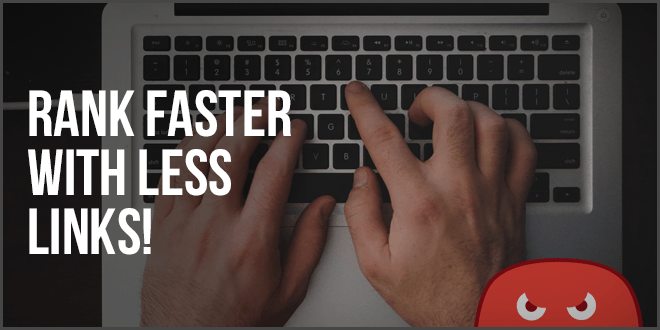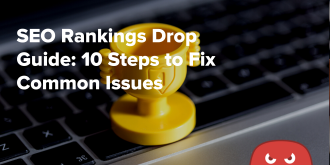Quick Links
When I launched GuestPostTracker.com in 2016 I made the decision to focus on SEO as my main traffic source.
I needed results in Google quickly so I came up with a very strategic plan.
In less than a year, Guest Post Tracker ranked on page one of Google for almost every single key phrase I was targeting.
Let me show you exactly how I did it.
The 3 Part SEO Strategy For Safe & Fast Rankings
My SEO strategy had main 3 parts.
- Build brand trust with Google as fast as I could
- Use power pages to rank for my main key phrases
- Use SEO power of power pages to boost the rest of my pages
I have been in the SEO world for 15 years and knew that the fastest way to the top of Google these days was using this strategy.
Let me explain what I did in each step of the 3 part SEO plan in more detail.
Step 1: Build Brand Trust With Google
One of the most misunderstood principles of SEO is the importance of building trust with Google.
If you skip this step or don’t take it seriously, none of your other SEO efforts will amount to much.
Google loves brands because brands are able to get links naturally.
Whether it be through PR efforts, online advertising or just fans showing their loyalty, well-known brands have no trouble getting links.
Because of this Google trusts brands.
Well-known brands very rarely get hit by Google updates, and they rank all over the SERPs.
Here’s the thing about brands, they never target key phrases on their home page in their link building.
Don’t believe me? Go look at Amazon’s homepage backlinks. 90% of the anchors are either “Amazon” or “Amazon.com” (or some other form of the URL).
A trusted brand only gets these kinds of non-keyword backlinks to their homepage, and they get a lot of them.
So my first strategy with Guest Post Tracker was to mimic what big brands do.
I went out and got links from business/marketing related sites that had a majority “GuestPostTracker.com” and “Guest Post Tracker” as the anchor.
I wanted Google to know I was not some fly by night AdSense site, but that I was a real business with a real brand.
I started guest posting like crazy (yes guest posting is alive and well).
I used my own list of guest blogging sites at Guest Post Tracker to get some high-end blogs to link to me.
I then used a blogger outreach service to fill in the gaps of the links I still needed to build out a #1 ranked backlink profile.
All along the way, I was using the homepage link map SEOJet had built for me. The link map told me exactly which anchors to use with every link I built (more on SEOJet later).
Step 2: Create SEO Power Pages To Rank For Key Phrases
An SEO power page is a page in your site that has enough awesome content to support a lot of links naturally pointing to it.
In other words, its the type of content that when people read it they love it and feel compelled to leave a comment or even link to naturally.
Editor Note: This is also sometimes called “pillar content” or a “linkable asset” – something that’s actually worth linking to as opposed to a product page. This makes the whole white hat link building process 10x easier because other blogs are happy to link to valuable resources.
This is your top tier content.
Often times this will be a blog post that is 2000 plus words.
In other cases, it is just an important page in your site.
Either way, you strategically use these pages for two purposes:
- First, you choose one or two of your most important keywords and heavily target those keywords on the page.
- Second, through link building, you build up the SEO power of the page and then pass that power to smaller pages through internal links.
The reason we target keywords on the power pages is that is what Google expects you to do.
Based on the backlink research we have done for SEOJet, non-homepage power pages typically have 55%-75% of their backlinks with some keyword reference in the anchor text.
Luckily, a link map inside of SEOJet will tell you exactly which anchors to use every time on your power page.
So my strategy for Guest Post Tracker for the first few months was to build about three times as many links to the homepage as I was building to all of the other pages combined.
I say “all other pages” as if it was a lot of pages I was building links for, but in reality it was only 5-6 pages including my homepage.
As I built links to the site I was literally just following what each link map was telling me to do.
All the while my backlink profile for every one of these pages matched what a #1 ranked backlink profile looks like.
In other words, all along the way it always looked extremely natural to Google.
Step 3: Use Power Pages To Pass SEO Value To Rest Of Your Site
I mentioned that power pages served two purposes in my overall SEO strategy, this is the other breakthrough that allowed my site to rank for almost every single keyword I was targeting.
The reason SEO power pages are so great (and powerful) is that as you build up the SEO juice to these pages, not only do they rank for their own targeting keywords, but they also can pass that juice onto other pages in your site as well by just using internal linking.
Guest Post Tracker has about 30 category pages that list blogs that accept guest posts in that category.
For example, our Real Estate category page lists all of the real estate blogs we have found that will accept a guest post.
The pages don’t have a ton of content other than the list of blogs and it wouldn’t be natural to build a lot of links to those pages (plus it would be extremely expensive).
In order to get these category pages to the top of Google, I needed to pass the SEO juice from my power pages to these pages.
I actually built the power pages and started building links to those pages to build up their SEO value.
Then once they had several links pointing to them I then added internal links from my power pages to my category pages.
Within days of adding links to my category pages, almost all of my category pages were showing up in the top 3 of Google for their respective keywords.
Go ahead and search “real estate guest post” and see where Guest Post Tracker comes up.
Now I know that some will argue that most of the keywords from those category pages are not very competitive.
But that is exactly why this strategy works so well. I didn’t have to build any links to those category pages to get them to the top 3 of Google.
While I was building links to a power page that was targeting one of my big key phrases, I was able to use that effort to promote my other pages.
It meant a huge jump in both traffic and conversions.
How To Get More Results With Less Links
Within a few months of launching one of my power pages, I noticed that I had made it to the top 3 of Google for the keywords I was targeting on that page.
I was happy to see that my strategy was really working and that the link maps from SEOJet were guiding me in the right direction.
I then decided to look at all of the other people in the top 6 of Google for the same phrase I was ranking for to see how many links they had pointing to their page verses how many I had pointing to mine.
I was shocked to see that while the other sites ranged from 70-600 links pointing to their pages, I had only 8 links.
8 links, with a site that was about 6 months old.
This was my big ah-ha moment.
By following the link building strategy that SEOJet had given me I was able to get top 3 rankings with 70% less links.
Now keep in mind that I would never have just stopped building links at that point.
In fact, I will always build links no matter if I rank #1 or #100.
Good link building is the way to really dominate search results.
But it was awesome to see I could get results so quickly because I had built brand trust and then built amazing backlink profiles on my power pages.
This also meant that I saw a big jump in site revenue from search traffic.
Link Building Schedule
You’re probably asking yourself how often I was building links, or how many I built per month.
It might actually surprise you that for the first year I was only building about 6-10 links to the site per month.
But here’s the catch, all of those links were from guest posts on extremely relevant blogs.
In fact, probably 90% of my links were from guest posts.
As I mentioned before I used Guest Post Trackers list to do my own outreach and get some high DA links and used an outreach service to fill in the blanks on my link maps.
I made sure the blogs I was getting links on had some kind of social presence, and then I would build links to my links (also known as tiered linking or link stacking).
By building links to my links I was increasing the SEO value of the page linking to me (the power page strategy) and I was also using good keyword anchors to link to those pages so I could manufacture better relevance with each link I got.
All of this has added up to Guest Post Tracker receiving over 5000 visitors a month just from search.
The best thing about this strategy is as Google continues to make updates to their algorithm, my rankings continue to increase because I built a natural anchor text distribution.
Now I mentioned before that all throughout this process I was using SEOJet to effectively implement this 3 part SEO strategy.
SEOJet is SEO software that gives you a proven link building plan (link maps) you can follow so your backlink profile matches a #1 ranked profile on Google.
It takes all of the guesswork out of what anchor text you need to use for each link. By using real data from #1 ranked websites, SEOJet tells you exactly which anchor to use for every link you get.
Essentially it helps you copy exactly what the top dogs are doing so you rise to the top of Google quickly.
Go ahead and give it a try and see how it works for your client’s sites.
Get 25% off SEOJet through the HOTH partners page or you can also see a demo of SEOJet here.








When I started my website it was all learning on the go, so I head no backlink strategy, which I think was probably a bit of a mistake. It’s taken a while to get some creditable backlinks, and though I have a few, I don’t have loads. I want to start link building more now, but I really struggle to find similar websites to guest post on, plus finding the time to do this is difficult. Did you have to put aside much time to achieve this?
We created a post to show you how to do it here: https://www.thehoth.com/blog/how-to-get-white-hat-links/
We also created a service that does it for you here: https://www.thehoth.com/guestpost/
Cheers!
You should offer a link building service for those who are too busy to follow this plan. Thanks for laying it out by the way.
What is your opinion on niche real estate link building vs general link building?
Hey,
You can use the software to make sure your links have the right amount of optimization (https://seojet.net/getstarted_hoth.php?dst=Hoth_signup).
If you’re looking for a managed service that takes this all into account, you can check out https://www.thehoth.com/hoth-x/
Siam, I always value relevant links over general links, and I think Google does too. Getting links that are relevant to your site have more power regardless of what the DA is.
I have been using both tools Guest Post Tracker and SEOjet for my Digital Agency and have seen the same increase in stats, you CAN get better rank with fewer links using the link mapping software. I would recommend it to other agencies!
Thanks for the endorsement Chris!
How do you handle guest blog posting for enterprise clients? I typically run in to a few issues:
1. They want to control the content that is put out for them. They see it as brand management. Use a pen name?
2. It takes clients for ever to produce blog posts.
3. They are very particular where they content shows up to avoid being seen in a “rough neighborhood/website”
I’m considering just developing content that is related but appearing as though it’s from the client and using a pen name. Then referencing the clients site in the article but not stating a relation ship. Thoughts?
Julian, I like your idea and that is how I would probably handle it. I would put out guest posts from a pen name and just reference one of your client’s high content pages in the guest post. In the natural world of link building that is how it would happen anyway.
Great blog post and this will fit in perfectly with the excellent link building The Hoth provides. It’s a shame that SEO Jet doesn’t offer a free trial, but will probably start on the Small Business package before upgrading. The 25% discounts helps! Thanks guys.
Oliver, Im glad you liked the post. Let me know if you have any questions as you use try out the software.
WOW. I just watched Adam’s Demo video.
some very deep insight on what Google is looking for. I had the same AH ha moment when he shared some of his methods.
He has built a very powerful piece of software. definitely, a game changer if you use it. Thank you for the share Hoth.
Al, I’m glad you liked the demo. The SEO strategies I go over in it have proven over and over again to get awesome results with Google.
This is the best case study strategies and plan for link building and with the HOTH X Webinar execution plan I can quickly get to the top of page #1 on Google with few backlinks and within few months. Thanks for sharing such insightful plans for building natural links.
Ndifreke, I’m glad you liked the article.
Hey Adam
I love these strategies. The Power pages make so much sense to me. The ah-ha light came on.
While I have not done much with getting other sites to link to mine, I have been working on my internal linking for other relevant posts. I am finding that readers are staying on the site longer. Now I just need a little boost from Google as I am trying to revitalize and raise up a site that I neglected for a long time.
I recently started writing longer posts to get some traction. Today’s was about 2500 words! Yikes. It’s definitely time consuming but many of my readers have already let me know they got a lot of value.
Thanks again for your great advice!
Lisa
Lisa, that is the right approach. Create articles that have such awesome content that people will thank you for writing them.
Educative article here. What about the age of a website: how much weight does that have in a site’s rankings. Also is it worthwhile having some of your keywords in your site’s domain name?
Eric, I’m not sure how much age matters anymore. GuestPostTracker.com is about a year and a half old but started ranking for everything within 6 months of launch.
I like how everyone is putting them in the same basket as PBNs and I can vouch for guest posting as a viable link building strategy.
Stan, you and me both. Guest posting works like magic.
Great article & very actionable – quality & relevance over quantity for backlinks is the way to go – though Guest posting is laborious or expensive if paying.
It’s all about the ROI – If you rank highly for your targeted terms, what would be considered initially “expensive” can turn into a great investment.
Alison, that’s exactly right, quality and relevance. Guest posting for me has had the highest return of all of my marketing channels.
Hi Adam,
Thank you for the actionable insight!
Could I use the same strategy for local? Can I create a niche brand and power pages to then internally link out to my local pages on the same domain in the same niche?
Thanks again
Yes, this is a great strategy even for local. I’m not sure what niche you’re in but you could create an epic tutorial on how to do something and get links to that page. Another way I’ve seen it done is to create a local-specific resource like a local event calendar and get lots of local links that way.
Darky, yeah you definitely can. The one thing I always tell people doing SEO for local businesses is to leave the city name out of the anchor text for the most part. Let the on-page SEO tell Google what city you are targeting, it looks a lot more natural that way.
This is some great info. Thanks Adam. Makes sense to use Page Title for anchor. Going to double check things on that.
Do you offer a free trail on SEOJet?
Harris, yeah the page title anchor really helps move the needle as long as you don’t abuse it. We dont have a free trial but we do have a 30 day money back guarantee. Best of luck!
Good article. How do you find new blogs that allow guest posting?
Ross, I literally do Google searches using search strings like the following – business “write for us”, but Guest Post Tracker has such a big list now I am working my way through that.
Hey Adam, thanks very much for the link to SEO Jet. I had never some across that tool before. I’m going to give that a go – got my invitation already 🙂
Chris, thats great! I’m excited to see how it works out for you.
Got some awesome tips and techniques here that I could incorporate with my current link building process. Thanks so much for sharing this informative post.
Awesome! Glad to hear you’re putting this to use.
I am new in SEO industry. I have a website. I want to create backlinks for my site. But I am so confused about my link building plan. As a new bee, I am in hesitation about from where I can start my SEO project. I know it is time-consuming. If there have any suggestion for me then kindly mention me.
And thank you for this link building plan.
You should book a call with us here:
https://www.thehoth.com/meet/